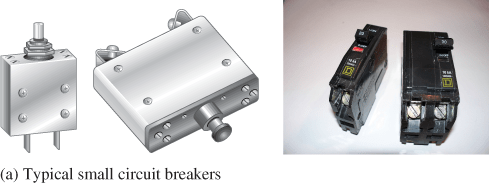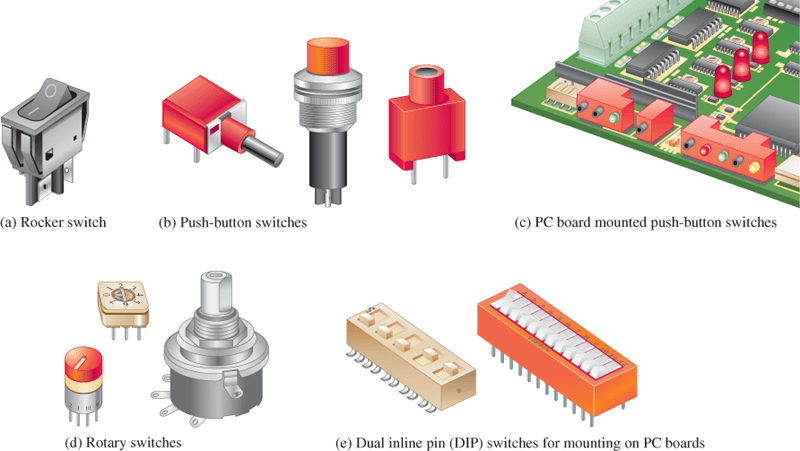Fuses and circuit breakers are placed in the current path of an electric circuit. They are used to create an open (break in the circuit) when the current exceeds a specified number of amperes due to a malfunction or other abnormal condition.
The basic difference between a fuse and circuit breaker is that when a fuse is “blown” by excessive current, it must be replaced, but when a circuit breaker trips (opens), it can be reset and reused repeatedly.
Both of these devices protect against damage to a circuit due to excessive current and prevent a hazardous condition created by the overheating of wires and other components. Because fuses cut off excess current more quickly than circuit breakers, fuses are used whenever delicate electronic equipment needs protection.
Figure 1: Typical Fuses
Fuses
Two basic categories of fuses in terms of their physical configuration are cartridge and plug type.
Cartridge fuses have housings of various shapes, with leads or other types of contacts as shown in Figure 1(a).
A typical plug fuse with a screw-in base is shown in Figure 1(b), and the schematic symbol for a fuse is shown in Figure 1(c).
A fuse is a non-resettable protective device that opens the circuit when there is excessive current. Fuse operation is based on the melting temperature of a wire or other metal element. As current increases, the fuse element heats up, and when the rated current is exceeded, the element reaches its melting temperature and opens, thus removing power from the circuit.
Two common types of fuses are the fast-acting and the time-delay (slow-blow). Fast-acting fuses are type F; time-delay fuses are type T. In normal operation, fuses are often subjected to intermittent current surges that may exceed the rated current, such as when power to a circuit is first turned on. A slow-blow fuse can tolerate greater and longer-duration surges of current than a fast-acting fuse can.
Circuit Breakers
Typical circuit breakers are shown in Figure 2(a), and the schematic symbol in Figure 2(b).
Generally, a circuit breaker is a device that detects excessive current either by the heating effect of the current or by the electromagnetic field that the current creates and opens the circuit.
In a circuit breaker based on the heating effect, a bimetallic spring opens the contacts when the rated current is exceeded. Once opened, the contact is held open by mechanical means until it is manually reset. In a circuit breaker based on an electromagnetic field, the contacts are opened by a sufficient magnetic force created by excess current. These contacts must also be manually reset.
Ground Fault Circuit Interrupter
The ground fault circuit interrupter (GFCI) is a type of circuit breaker that is used to protect from severe or fatal electric shock.
A GFCI detects a ground fault, which is an unintentional electric path between a source of current and a grounded surface, resulting in a leakage current. (If your body provides that path to ground for the leakage current, you could be electrocuted.)
Figure 2: Typical Circuit Breakers and Schematic Symbol
The National Electrical Code requires GFCI devices intended to protect people to interrupt (trip) the circuit if the leakage current exceeds 4 to 6 mA of current within 25 ms.
A GFCI device that protects equipment (equipment protective device) is allowed to trip at currents as high as 30 mA. GFCI receptacles can be found in kitchens, bathrooms, and other places that can be wet, such as outdoor locations.
Mechanical Switches
Mechanical switches are commonly used for controlling the opening or closing of circuits, such as turning a lamp on or off. When a switch is off, the circuit is open; when a switch is on, the circuit is closed.
Switches are usually classified according to the number of positions and contacts. Figure 3 shows the types of switches.
Figure 3: Switch Symbols
SPST: single-pole, single throw, SPDT: single-pole, double-throw, DPST: double-pole, single-throw, DPDT: double-pole, double throw, NOPB: normally open push button, NCPB: normally closed push button.
A switch pole is a contact, and a throw is a movable part. Figure 4 shows several varieties of switches.
Figure 4: Typical Mechanical Switches
Review questions
- What is the purpose of a fuse? Of a circuit breaker?
- Name two types of fuses in terms of operation.
- How does a circuit breaker differ from a fuse?
- Name two ways that circuit breakers detect excessive current.
Answers
- To protect a circuit by breaking the path when the current exceeds a certain specified amount
- Cartridge and plug types
- A circuit breaker can be reset after the condition that tripped it is corrected; a fuse is a one-time device and must be replaced.
- Circuit breakers can operate based on a heating effect or by detecting the electromagnetic field.





